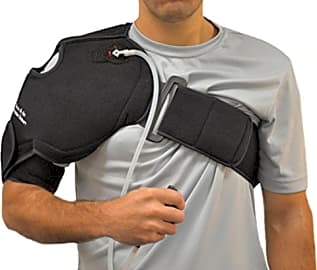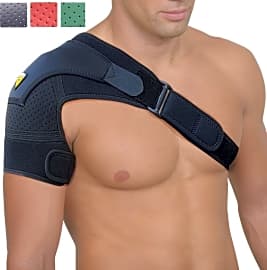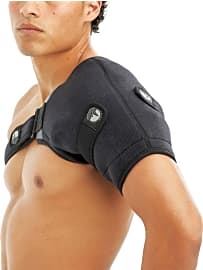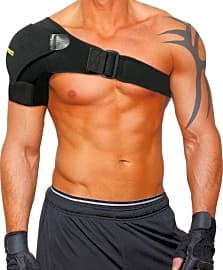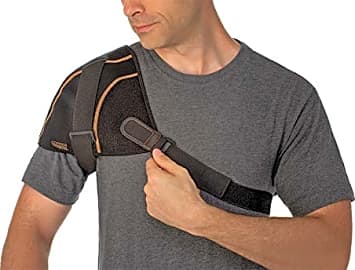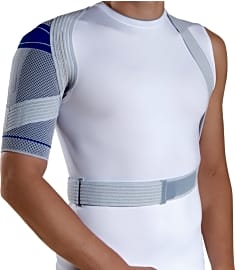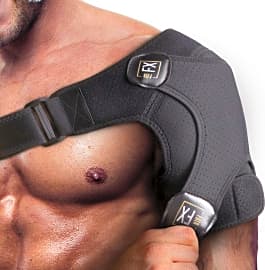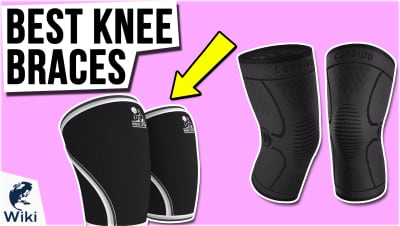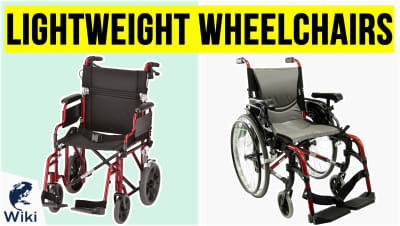The 10 Best Shoulder Braces

This wiki has been updated 39 times since it was first published in September of 2015. If you've got a bum shoulder, these braces can help support your joint, taking the strain off and enabling you to perform your day-to-day tasks with less pain and discomfort. There are options here for everything from restricting movement to allowing total range of motion, while offering snug compression. Before you make your choice be sure to have the injury checked by a doctor. When users buy our independently chosen editorial picks, we may earn commissions to help fund the Wiki.
Editor's Notes
October 02, 2020:
When dealing with an aching shoulder, whether acute or chronic, be sure to confirm with your doctor or physical therapist that a brace is appropriate and that you are choosing the correct type for your individual recovery.
We continue to like the Saunders Sully, as it can be used to stabilize, restrict movement, or for support during activity depending on how you adjust the straps. If you want a serious brace with hot/cold therapy built-in, the Natra Cure Hot and Cold Compression and the AW Active Wrap both provide gel packs and pockets for holding them. Their bulk does not make them useful for active wear, where as the Saunders Sully conforms to your body well and could be worn to work or light activity.
For this update we replaced the Leatt Anatomically Correct, since it is made specifically for one side of the body or the other, with the Fightech Aid Pro that goes on the right or the left shoulder. You'll also get gentle support and compression from the Fightech, plus it's slim and form-fitted to be comfortable for those who need to sleep with a brace on.
August 14, 2019:
It is no secret that shoulders are prone to injury. We use them regularly throughout our day, not to mention when performing nearly any kind of fitness routine or participating in sports. Whether you already have an injury and want to speed it on its way to recover, or simply want to prevent one, we have found a shoulder brace for you. Before using any of these for post-op relief or to aid in the healing of a serious injury, you should always check with your doctor to make sure it is the right path for your particular needs.
Those who need to combine support with temperature therapy can look to the Copper Fit Rapid Relief, ActiveWrap BAWSH11, Babo Care Stability, NatraCure Hot and Cold Compression, and PainFX Rotator Cuff Support. While not all of these actually come with the gel pack, they do all feature some kind of pressure pad or pocket for holding one in place. It is worth mentioning that hot or cold therapy is generally intended for short periods of time, such as 20-minute sessions.
If temperature therapy doesn't matter to you and you are simply after some compression and support, consider the Saunders Sully, Leatt Anatomically Correct, EVS Sports SB03, Zamst Wrap 748, and Bauerfeind OmoTrain. Of these, the Bauerfeind OmoTrain is the slimmest and easiest to fit discreetly under your regular clothing, while the Saunders Sully, Leatt Anatomically Correct, and EVS Sports SB03 offer the most coverage and have the least chance of sliding out of place throughout the day.
Special Honors
Kinetic Innovations Shoulder Brace Unlike many other options, this brace is designed to only limit harmful motions that can cause subluxation or dislocation, while still allowing you to perform every other action without hindrance. Another noticeable difference between this and others is the use of non-elastic straps that provide a definite end point to your range of motion. kineticinnovations.com
Aryse SFast The SFast has been specifically designed to facilitate ease of use. It has a one-piece structure that makes it simple to fit, and it utilizes polyurethane straps to adjust motion restriction. It offers very large coverage too, which can help provide your shoulder with healing warmth, though some may find this may causes sweating. aryse.com
A Shoulder On Ice
My shoulder and my neck crashed into the junction of the boards and the ice with the full weight of my body at about 20 mph.
I almost made it to thirty-years-old before ever breaking a bone. I wasn't careful; I was lucky. I did, over the course of all that time, encounter my fair share of sprains. I sprained my ankles about a dozen times, my wrists here and there, my knees once in a while, and my elbows quite a bit, as well.
The worst sprain I endured was a shoulder sprain. I've been an ice hockey player since I was four, and that's a sport that comes with a lot of injuries. I'd had a little rivalry going with a guy in one of my recreational leagues, and he decided – rather than drop the gloves and fight me (which is totally legal in hockey, by the way) – that he would do the dirtiest thing you can do to another player: he hit me from behind.
My shoulder and my neck crashed into the junction of the boards and the ice with the full weight of my body at about 20 mph. I tore two of the three major tendons in my shoulder about 85% each, just tempered enough not to require surgery. That saved me a big medical expense, bit the recovery without surgical intervention ended up being much longer.
I was laid up with instructions to keep my shoulder in a brace for the better part of two months, and the braces I tried worked more or less the same as any other I'd used on previous injuries.
A brace works primarily as an immobilizer. Torn muscle and tendon tissues will heal much faster if you don't subject them to a lot of use, so having a little help to keep things still can mean the difference between a six week recovery and a six month recovery.
What's more pressing is that re-injury during the healing process can build up masses of scar tissue that might put pressure on nearby nerves or prevent you from ever regaining full mobility in the joint. A good brace will prevent this by fixing your injured shoulder to a healthy position for a given injury, and, in some cases, by aiding the healing process by compression, cooling, or even magnetic resonance.
Depending On the Tendon
There are a lot of ways you might injure your shoulder, and fitting a corresponding brace to your injury is the first step in determining which of the braces on this list will be the most helpful in your healing. The more advanced braces on our list have enough adjustment options that you could use them to target almost any shoulder injury, but some of our options are a bit more specific in their design.
Take, for example, shoulder braces that use the offset shoulder as a leverage point for bracing.
Take, for example, shoulder braces that use the offset shoulder as a leverage point for bracing. These appear to symmetrically stretch across the back and wrap around both shoulders at the same time. They are ideal for shoulder injuries related to your posture, or injuries to the anterior portion of your coracoacromial ligament.
In the case of my hockey injury above, I tore into the posterior section of my coracoacromial ligament as well as my supraspinatus tendon. The symmetrical leverage braces wouldn't necessarily have hurt my healing process, as they still would have partially immobilized the joint, but there was a risk that if the ligament repaired itself in a compressed position (like the one such a brace would have created), I might have lost some forward mobility.
Instead, I turned to the types of braces that elicit in their users the sense that they've become bionic. They strap below the opposite shoulder, and are immensely adjustable, so you can find a comfortable position in which to immobilize your injured shoulder that will promote the most thorough healing.
Some braces offer additional treatment variables, like cooling systems or magnets. After a certain point in the healing process, cooling is no longer necessary, so this kind of feature is only really useful for people with chronic shoulder problems who require frequent immobilization and relief for pain and swelling.
Immobilized For Millennia
Ancient Egyptian tombs and burial sites tell fascinating stories about the medical histories of their inhabitants. You can see once-broken bones that must surely have been set to achieve such a clean healing, as well as some pieces of ancient splints in the tombs with them. This evidence dates back to roughly 2465 BCE, and clearly shows how deeply an understanding of immobilization went with ancient man.
This evidence dates back to roughly 2465 BCE, and clearly shows how deeply an understanding of immobilization went with ancient man.
Almost 1,000 years later, a papyrus text was written by an unknown Egyptian medical scholar. The scroll, dubbed the Edwin Smith Papyrus after the famous Egyptologist, Edwin Smith, details several medical procedures from the top of the head on down, with occasional reference to the importance of immobilization.
Later, in a painting found in another Egyptian tomb dated to 1300 BCE, we clearly see a technique illustrated toward the reduction of a dislocated shoulder. Presumably ignorant of this painting, Swiss physician Emil Theodore Kocher would present a similar technique to the medical world some 3,200 years later.
While we have undeniably come extremely far in a great many fields of medicine, and as computer technology has mapped out our healing processes to excruciating detail, it's humbling to take a look at human medical knowledge from nearly 5,000 years ago and see the same tried and true techniques we practice today.



